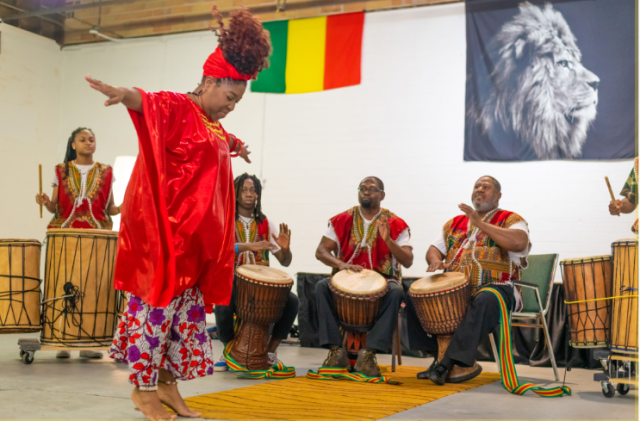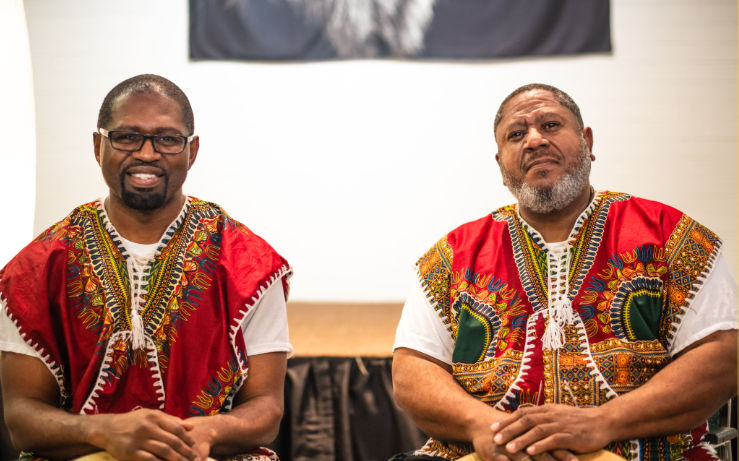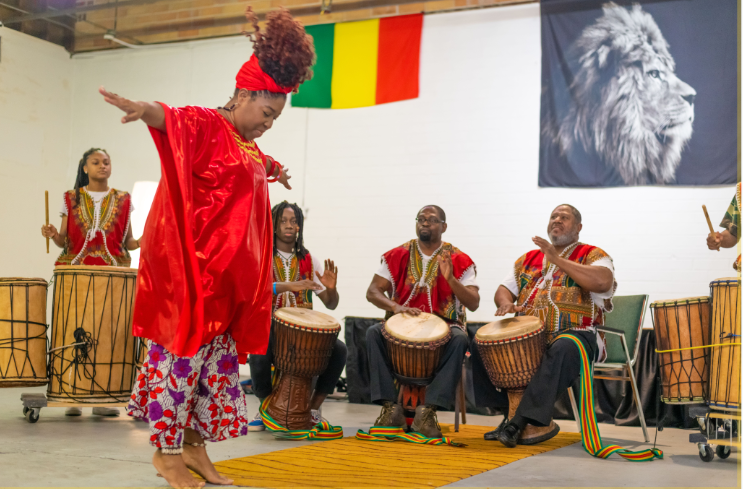
By Je’Don Holloway Talley
For the Birmingham Times
Even a gloomy, wet Saturday morning in January couldn’t stop drummers and dancers with the Sahi On Ko Djony West African Cultural Enrichment Program from brightening up and bringing energy to the Crescent Cultural Center in West Birmingham.
The group gathered for rehearsal in a space adorned with red, green, yellow, and black flags dangling from the ceilings and images of the African continent, Egyptian gods and goddesses, African women crossing the Sahara, and majestic lions displayed on the walls. As one of the drum instructors pulled up to the facility, two students went outside to help him unload the drums. As they set up, more students—drummers and dancers—arrived for rehearsal.
“Sahi On Ko Djony” is a Fulani term originating from the West African country of Guinea that means “The time is now.”
The mission of the enrichment program is for children and adults to not only learn about and preserve West African dance and folklore but also present it across the city and beyond.
“It was a way to save our children from the streets and give them an alternative to gang violence, teenage pregnancy, drugs, and so forth,” said Edmond “Barry” Johnson, 60, who organized the program in 1999 as an outreach to underprivileged youth in the Benjamin Green Housing Community in Grasselli Heights.
Johnson, who estimates that 100 youth have been in his program over the past 20 years, pointed to several benefits of the curriculum, including communal principles.
“Love And Respect”
“It teaches [participants about] pride and camaraderie, [and it shows them] how to stick together and how to love and respect each other,” he said.
Johnson noted the importance of keeping all year round the principles of Kwanzaa, the annual post-Christmas holiday celebration of African American culture that focuses on seven core principals, or the Nguzo Saba: Unity (Umoja), Self-Determination (Kujichagulia), Collective Work and Responsibility (Ujima), Cooperative Economics (Ujamaa), Purpose (Nia), Creativity (Kuumba), and Faith (Imani).
Sahi On Ko Djony performs across the region, including places like Montevallo, Montgomery, and Atlanta. They’ve taken classes and attended workshops at West African and Caribbean conferences. They’ve also performed in “The Brown Sugar Nutcracker,” a dance production, as well as events related to the Magic City Classic.
The group is comprised of seven drummers (group instructor Johnson, his son Nkosi Johnson, and his nephew Drequan Johnson, in addition to lead percussion instructor Ronique Carter and members Bria Davis, Jordan Franklin, and Wali Muhammad) and three dancers (lead and choreographer Maria Sullivan and members Nicole Clark and Ashley Toje).
Drummers
“For our beginning drum classes, we start like any musical class, teaching students how to keep timing and how to play [along] with different percussion instruments while being disciplined and holding their part in the music,” Johnson said. “The only prerequisites are to take the classes and love the art.”
Johnson explained that there are different drum parts in West African drumming.
“There are the bottom drums, which are the ‘Dundunba,’ ‘Sangba,’ and ‘Kenkeni,’ and the top drums, which are the Djembes,” he said. “In order to hold your part, you have to be disciplined enough to hear all this other music going around you and still know where you fit into the music.”
The Djembe, or jembe, has a body carved of hardwood and a drumhead made of rawhide, most commonly from goatskin; it is a rope-tuned, skin-covered goblet drum played with bare hands. The Dundunba is a family of West African drums that comes in threes; it is a rope-tuned cylindrical drum that has rawhide skin at both ends and is played with a stick.
Percussion instructor Carter said there is also “healing with these drums. … It brings joy to people’s hearts. … [Someone] could be having a rough day, and then come to hear us play, and it allows them to release that. Like when you’re doing yoga or something like that, you get the same kind of release here.”
Self-discipline is taught through music because “the music itself teaches that,” Johnson said. “We have a number of rhythms that have different meanings and are done for different celebrations. In the music, if you have a certain rhythm, you have different parts playing to make the fullness of the music. … As the maturity of the musician develops, then they will learn how to solo within those rhythms.”
Bria Davis, an 11th grader at Build Up Ensley High School, plays the Djembe and Dundunba drums.
“Playing the drums makes me feel closer to my ancestors and what they used to do before our time,” she said. “I feel a strong connection with them now, playing the drums and doing what they did.”
Connecting with the community is one of the most enriching parts of the programs for Davis.
“When you play the drums, you can really express yourself. And when you express yourself in front of your people and your culture, it brings out something in you that just feels crazy. … With pride and feeling like you belong, there’s nothing that can go wrong,” she said. “You feel like you’re at home and surrounded by people that you know and are your family, and you feel connected through the drums.”
Instructor Johnson, a Huffman resident, said all Sahi On Ko Djony students are taught West African studies, the history of the relationship between the dancers and drummers, “and how they complement each other.”
“You hardly ever have drumming without dancers. … As African Americans, we know that,” he said. “We hear music and start to dance. That’s something that is passed down to us from generation to generation.”
Dancers
Choreographer Sullivan agreed that dancers and drummers have a very unique connection.
“It’s a relationship,” she said. “If [the drummers] are dragging and sad, the music is going to drag, and the moves are going to be dragging and sad. If we can’t pick up our feet to move, they’ll eventually start dragging. It really is a relationship, and I like to share that with other people and teach them the relationship that music has to our people.”
Sullivan provides an introduction and teaches the history of dance traditions, such as the “Lamban,” “Djelidon,” and “Kuku,” which are high-energy dances of celebration.
“KuKu is a dance of the young people. It’s high and energetic,” she said. “It’s done during harvest time or when there is a new village leader, all celebratory moments. … I usually teach this when I’m teaching a group of young people because a lot of the movements correlate to many of the dances we do today.”
Another dance celebratory dance is the “Djole,” Sullivan said: “[During this] special dance done in the village square, … the men dance dressed in traditional [female] garb … [to pay] homage to the women in the village for being the creators of life. Women … bring forth life, they sacrifice themselves for life. … To [honor women], the [men] put on this show in traditional [female] garments. It’s really beautiful.”
History
There are two parts to Sahi On Ko Djony: the performance group and enrichment program at the Smithfield Recreation Center, which is open to all ages; and the Black Star Academy Home School Collective in Birmingham, where both Johnson and Sullivan are Artists in Residence and instructors, and Carter is a partner in facilitating the organization’s programming.
As important as the music and dance may be, there is just as much emphasis on history, Sahi On Ko Djony instructors said.
“I think the program impacts the city in a big way because a lot of times our people are not in touch with West African cultures. [This] allows them to see traditional dances and hear traditional music that date back to the 13th century in West Africa,” Johnson said. “We really focus on Afrocentric values. A lot of times, we as African Americans live a European-based life. What we like to do is incorporate the principles we had as a people in West Africa.”
He added that the West African spirit “allows the family to come together and do something they can all be a part of, whether it’s drumming, dancing, or singing. It draws us closer to know that this is where it all started, and this is what we naturally do. It also exposes [families] to something that goes back hundreds of years, [something] we are a part of that was taken away from us. It’s more of a rejuvenation of the West African spirit.”
Learning about the heritage and the history of African people means “we didn’t come here as slaves,” Johnson explained. “We were victims of human trafficking that resulted in us being enslaved. … Before we came here, we had kingdoms.”
Most children have heard of the Greek and Roman empires but not the Mali or Songhai empires, Johnson said: “I mainly encourage them to learn about us and the different ethnic groups of West Africa, like the Fulani, Susu, Bambara, Igbo, and others.”
Sullivan, a West End native and resident who is a single mom to a six-year-old daughter, said she loves the teaching part of what she does.
“I love sharing and being able to educate [black people] about us. I love being able to share this history with another child or adult. The culture can be healing,” she said. “That’s the one thing about West African dance and our history, in general: … It tends to be more so passed down through verbiage; nobody writes it down. I began to study and learn more history about the dances, where they came from, and the groups of people that performed these dances.”
Sahi On Ko Djony is looking forward to 2020.
“We want to educate, promote, provide, and teach more about our West African culture,” Johnson said. “When [the community] sees what we are doing, we want to let them know that this is not something new. This is something that was taken away from us, something that is hundreds of years old. [When we were brought to America], we were not allowed to play these drums and do these dances, but the time is now—Sahi On Ko Djony! We want to share our traditions and West African folklore.”
For more information visit the group on Facebook: @Sahi On Ko Djony
Birmingham Times staff reporter Erica Wright contributed to this post.




































